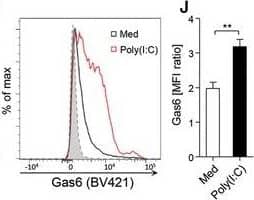Human Gas6 Biotinylated Antibody
R&D Systems, part of Bio-Techne | Catalog # BAF885


Key Product Details
Species Reactivity
Validated:
Cited:
Applications
Validated:
Cited:
Label
Antibody Source
Product Specifications
Immunogen
Asp118-Ala678
Accession # NP_000811
Specificity
Clonality
Host
Isotype
Scientific Data Images for Human Gas6 Biotinylated Antibody
Detection of Human Gas6 by Flow Cytometry
Inflammatory stimuli associated with viral infections upregulate Axl and promote Gas6 binding to macrophages. (A–E) MDMs were stimulated for 24 h with dexamethasone (Dex), LPS, IFN‐ gamma, poly(I:C) or IFN‐ alpha. (A) MerTK and (C) Axl protein expression determined by ELISA of total cell lysates (mean+SEM, n = 4). (B) MerTK and (D) Axl protein expression analyzed by western blotting; actin was used as loading control. A representative of two to three independent experiments is shown. (E) Flow cytometric analysis of Axl expression on MDMs stimulated with poly(I:C) or IFN‐ alpha for 24 h. Representative histograms of two independent experiments are shown; dotted line/shaded: FMO control. (F) Axl and MerTK relative mRNA and (G) protein expression in MDMs differentiated by 6‐day culture in M‐CSF or GM‐CSF determined by qPCR (mean+SEM, n = 6) and by ELISA of total cell lysates (mean+SEM, n = 3), respectively. (H) Axl, MerTK and Tyro3 relative mRNA expression in MDMs stimulated as in (A–C) analyzed by qPCR (mean+SEM, n = 2–3). (I and J) Flow cytometric analysis of Gas6 binding to MDMs stimulated with poly(I:C) for 24 h. (I) Representative of four independent experiments is shown; dotted line/shaded: isotype control. (J) Ratio of Gas6 to isotype control geometric mean fluorescence intensity (MFI)+SEM in unstimulated and poly(I:C)‐stimulated MDMs (n = 4). *p < 0.01, paired t‐test. ELISA and qPCR samples were assayed in duplicate. Image collected and cropped by CiteAb from the following publication (https://pubmed.ncbi.nlm.nih.gov/29400409), licensed under a CC-BY license. Not internally tested by R&D Systems.Applications for Human Gas6 Biotinylated Antibody
Western Blot
Sample: Recombinant Human Gas6 (Catalog # 885-GS)
Reviewed Applications
Read 1 review rated 5 using BAF885 in the following applications:
Formulation, Preparation, and Storage
Purification
Reconstitution
Formulation
Shipping
Stability & Storage
- 12 months from date of receipt, -20 to -70 °C as supplied.
- 1 month, 2 to 8 °C under sterile conditions after reconstitution.
- 6 months, -20 to -70 °C under sterile conditions after reconstitution.
Background: Gas6
Gas6 (Growth Arrest Specific 6) is a multimodular protein that is upregulated by a wide variety of cell types in response to growth arrest (1). Gas6 and the structurally related Protein S are vitamin K-dependent and have an extensively gamma-carboxylated N-terminal Gla domain, four EGF-like repeats, and a C-terminal region with homology to steroid hormone binding globulin (SHBG) (2). Human Gas6 is a 75 kDa protein that shares 77-79% amino acid (aa) sequence identity with mouse and rat Gas6 and 43% aa sequence identity with human protein S (over the region expressed). Alternate splicing generates isoforms that lack the Gla domain and/or the spacer between the EGF-like and SHBG regions. Gas6 binds and induces signaling through the receptor tyrosine kinases Axl, Dtk, and Mer (3-5). Human Gas6 interacts with both mouse and rat orthologs of these receptors (1). The full length isoform may be cleaved, resulting in release of the free SHBG region which can independently activate Axl (6). Shed soluble forms of Axl and Mer bind Gas6 and function as decoy receptors (7, 8). Gas6 induces a variety of responses, including prevention of apoptosis (9), cell proliferation (10), platelet-mediated thrombosis (11), retinal epithelial cell phagocytosis of outer rod segments (12), inhibition of VEGF‑induced endothelial cell chemotaxis (13), and the differentiation and expansion of NK cell precursors (14). The affinity of Gas6 for phosphatidylserine likely contributes to its role in promoting the phagocytosis of apoptotic cells (15). Several of these effects have been shown to require gamma-carboxylation of the Gla domain (12, 16).
References
- Hafizi, S. and B. Dahlback (2006) FEBS J. 273:5231.
- Manfioletti, G. et al. (1993) Mol. Cell Biol. 13:4976.
- Stitt, T.N. et al. (1995) Cell 80:661.
- Ohashi, K. et al. (1995) J. Biol. Chem. 270:22681.
- Nagata, K. et al. (1996) J. Biol. Chem. 271:30022.
- Goruppi, S. et al. (1997) FEBS Lett. 415:59.
- Sather, S. et al. (2007) Blood 109:1026.
- Budagian, V. et al. (2005) Mol. Cell. Biol. 25:9324.
- Shankar, S.L. et al. (2006) J. Neurosci. 26:5638.
- Yanagita, M. et al. (2002) J. Clin. Invest. 110:239.
- Gould, W.R. et al. (2005) J. Thromb. Haemost. 3:733.
- Hall, M.O. et al. (2002) Exp. Eye Res. 75:391.
- Gallicchio, M. et al. (2005) Blood 105:1970.
- Caraux, A. et al. (2006) Nat. Immunol. 7:747.
- Wu, Y. et al. (2005) J. Cell Sci. 118:539.
- Hasanbasic, I. et al. (2005) J. Thromb. Haemost. 3:2790.
Long Name
Alternate Names
Gene Symbol
UniProt
Additional Gas6 Products
Product Documents for Human Gas6 Biotinylated Antibody
Product Specific Notices for Human Gas6 Biotinylated Antibody
For research use only